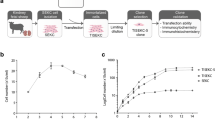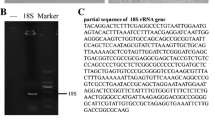Summary
The optimum temperature for the growth of porcine stable (PS) kidney cell line is 37°C. We have adapted the cell line to grow at 40°C. The original cell line grown at 37°C has been denoted as PS-37, and the adapted new strain has been denoted as PS-40. Both the cell lines were screened for mycoplasma by Hoechst staining and tritiated uridineuracil uptake and were found to be negative. Comparative characterization of PS-40 and its progenitor PS-37 cell line was done by using various parameters. The antigenic studies indicated that the new cell strain was not cross-contaminated with any other cell lines. It was observed that PS-40 cells were more fibroblastic with clean cytoplasm and appeared healthy. The growth of PS-40 cells was faster than the original cell line. The karyological study showed heteroploid chromosome number in PS-40 cells. The modal chromosome number of PS-40 cells was 58, whereas that of PS-37 cell line was 38. The lactic dehydrogenase isoenzyme pattern showed a cathodal shift of bands. The PS-40 cell strain could be cryopreserved and revived. The viability of PS-37 as well as PS-40 cell lines is in the range of 90–95%, and the growth characteristics of thawed cells showed six-to eightfold multiplications within 5d. The virus susceptibility study revealed that the cytopathic effect was more profound and observed 1 d earlier in PS-40 cell line. Increased yields of Japanese encephalitis, Sindbis, and Semliki forest viruses were obtained by 1.8, 1,75, and 1.5 log plaque-forming units/ml. respectively. The yield of West Nile virus was, however, comparable to that in PS-37 cell line. Both the cell lines were refractory to Dengue viruses.
Similar content being viewed by others
References
Anderson, R. L.; Minton, K. W.; Li, G. C., et al. Temperature induced homeoviscous adaptation of Chinese hamster ovary cells. Biochem. Biophys. Acta 611:331–338; 1981.
Chen, T. E. In situ detection of mycoplasma contamination in cell culture by fluorescent Hoechst 33258 stain. Exp. Cell. Res. 104:255–262; 1977.
Dulbecco, R.; Vogt, M. Biological properties of poliomyelitis viruses as studied by plaque technique. NY Acad. Sci. 61:790; 1955.
Kurri, G.; Oliver, A. Maintaining mosquito cell line at high temperature: effect of replication of Flaviviruses. In Vitro 25:193; 1989.
Lavine, F. M. Mycoplasma contamination of animal cell cultures: a simple rapid detection method. Exp. Cell. Res. 74:99–109; 1972.
Paranjape, S. P.; Kadam, V. D.; Deolankar, R. P. Increased yield of Japanese encephalitis virus in heat shocked cell cultures. Acta Virol. 38:333–337; 1994.
Paterson, W. D.; Simpson, W. F. Jr.; Hukk, B. Cell culture characterization: monitoring cell identification. In: Jakoby, W. B.; Pastan, I. H. ed. Methods in enzymology, 58, New York: Academic Press; 1979:164–178
Author information
Authors and Affiliations
Corresponding author
Rights and permissions
About this article
Cite this article
Paranjape, S., Patil, B.R. & Kadam, V.D. Characterization of porcine stable kidney cell line adapted to hyperthermic temperature. In Vitro Cell.Dev.Biol.-Animal 39, 193–195 (2003). https://doi.org/10.1290/1543-706X(2003)039<0193:COPSKC>2.0.CO;2
Received:
Accepted:
Issue Date:
DOI: https://doi.org/10.1290/1543-706X(2003)039<0193:COPSKC>2.0.CO;2




